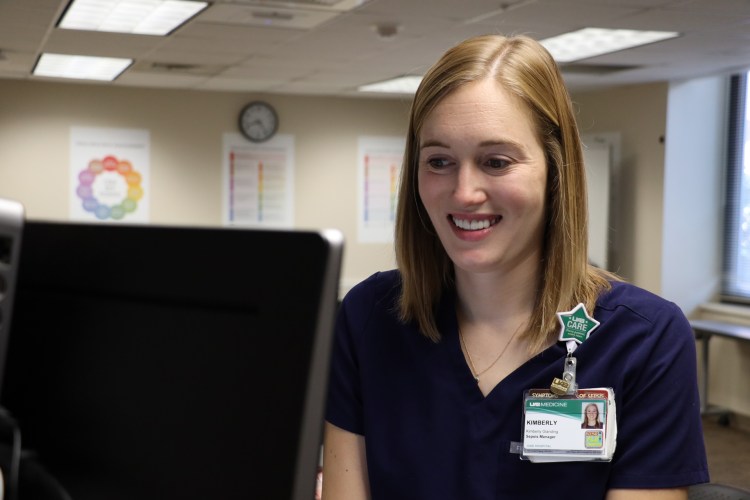Clinical Simulation, UAB Care host sim for psychiatry

Caring means sharing — and simulation.
This past June, UAB Clinical Simulation collaborated with UAB Care to conduct an in silico (computer-based) simulation for residents and nurses in the Department of Psychiatry and Behavioral Neurobiology.
UAB Care is a systematic quality improvement initiative established by UAB Medicine in 2014 in light of the evolving health care and economic environment.
The June simulation focused on the Code Sepsis process, tasking an interprofessional team with delivering care to a patient, while interacting with emergency medical responders and each other to determine the cause of the patient’s distress. This particular simulation welcomed residents and nurses from the Department of Psychiatry and Behavioral Neurobiology.
“These simulations help examine successes and opportunities throughout the Code Sepsis process,” said April Belle, Clinical Simulation’s director of systems simulation. “They also create an interactive method for reinforcing Code Sepsis education to support UAB’s mission of reducing mortality related to sepsis.”
Interprofessional teamwork is key, said Kimberly Glanding, sepsis program manager with UAB Care.
“The design of the simulation encourages information sharing and communication amongst disciplines while also learning from one another,” Glanding said.
After each simulation, a summary is shared to discuss lessons learned surrounding teamwork and communication, identification and treatment of sepsis, and documentation of sepsis. According to Glanding, the learners’ takeaways are significant.
“They’re aware that we have a sepsis power plan and Code Sepsis team, while learning unique clinical perspectives; for example, when considering antibiotics, does one consider bacterial coverage or time to administration?” Glanding said. “They also learn about communication, such as what information is helpful to include in a page, as well as sharing the threshold for re-escalation or notification.”
According to Belle, Clinical Simulation and UAB Care are planning to host monthly simulations in various practice areas to improve UAB’s sepsis response and encourage urgency with the care of such patients.
“We hope to engage all members of the health-care team who encounter patients with sepsis,” Belle said.
“The Clinical Simulation team always does a great job making everyone feel safe and comfortable,” Glanding added. “The team is proactive and quickly adapts as our processes change. I think the learners enjoy the dedicated time of collaboration and learning with one another. Our content experts are essential to our simulation success as they share how they manage like situations, as well as additional clinical considerations.”
To learn more about UAB Care, visit here. For more information on how your interprofessional team can benefit from simulation, email UAB Clinical Simulation at simulation@uabmc.edu.
UAB Medicine’s Clinical Simulation program offers opportunities for individuals and teams across UAB Medicine and beyond to practice before they deliver care. We encourage all who provide and support patient care to “SimFirst.” Together, we can put our patients’ safety first.




0 Comments